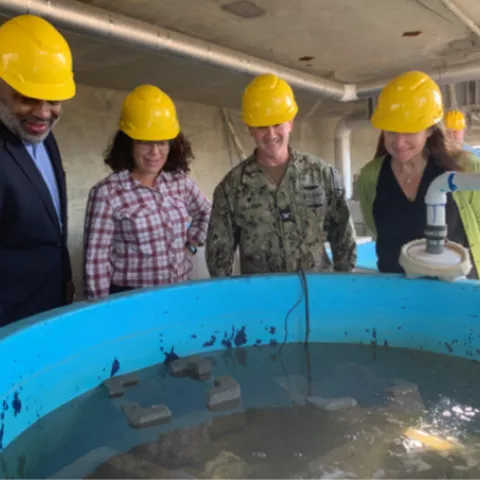
You are viewing ARCHIVED content published online before Jan. 20, 2025. Please note that this content is NOT UPDATED, and links may not work. Additionally, any previously issued diversity, equity, inclusion or gender-related guidance on this webpage should be considered rescinded. For current information, visit News Items | Bureau of Safety and Environmental Enforcement.
For more than three centuries, the NY-NJ Harbor Estuary suffered from pollution and habitat destruction. As the water's health declined, oysters and other shellfish became contaminated. The NY/NJ Baykeeper, a group dedicated to protecting, preserving, and restoring the ecological integrity and productivity in the NY-NJ Harbor Estuary, is working to bring back the oyster population in Raritan Bay.
Ten years ago, NY/NJ Baykeeper needed to find a new home for two oyster reefs it was cultivating in the waters off Atlantic Highlands and Keyport. Baykeeper and their state partners feared poachers would take the oysters from the contaminated waterway to sell as food, possibly causing illness in those who ate them. At the time, it was seen as a major setback in the effort to reintroduce oysters to Raritan Bay.
A number of county and state organizers and representatives knew of Baykeeper's challenge in finding a new site to further develop its oyster project. Someone suggested a potential host for the oysters would be Ohmsett, the National Oil Spill Response & Renewable Energy Test Facility, located on Naval Weapons Station Earle (NWSE) in Leonardo, New Jersey.
Managed by BSEE, Ohmsett is the largest outdoor saltwater wave/tow tank facility in North America and is the only facility where full-scale oil spill response equipment testing, research, and training can be conducted in a marine environment with oil under controlled environmental conditions.
Recognizing they share a common mission for ensuring the protection of coastal and marine environments and improving water quality for communities along the coast, BSEE Ohmsett was immediately supportive of the collaboration.
"We at BSEE know that all the incredibly diverse ocean plants and animals are valuable, not only economically but environmentally, and that is why marine ecology is a critical component of BSEE's environmental stewardship mission," said Karen Stone, BSEE's Response Research Branch Chief who oversees Ohmsett. "Facilitating oyster cultivation that will eventually serve to protect the New Jersey shoreline and improve water quality at the same time makes perfect sense and is a great way to support the environment and local marine life."
Oyster larvae are grown in four large aquaculture tanks in a shaded area at the Ohmsett facility and then released onto oyster reefs called "castles" in Raritan Bay, where Baykeeper monitors them for growth and survivorship. Baykeeper also monitors water quality and studies biodiversity around the reef.
"The oysters help keep water clean and their reefs help protect the coastline from erosion," said Ohmsett Liaison Michael Brennan. "The tanks are also a popular destination for official visitors and give Ohmsett staff an opportunity to talk about the positive environmental impact oysters provide."
As the oysters reach maturity at Ohmsett, Baykeeper removes and introduces them into the local bay. In addition to a secure location for oyster harvesting, Ohmsett provides logistical support and electrical power to filter the tanks.
"This initiative demonstrates how partnerships such as this can benefit the environment," said Stone. "We welcome the opportunity to help make a difference in the local environment, and we look forward to the continued growth of this program and its positive impact on the health of the Bay."
